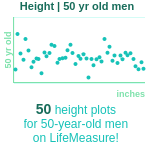Men Height chart for Middle Aged Adults 50 years old

General Summary: 50 year old men height
In most cases, height measurements for 50 year old men will be in the range between 164 and 190 cms. The average height for 50 year old men is 178 cms, according to the CDC and anonymized data from users.
All Results
Enter your height measurements above to see how they compare
So far, we have recorded 0 height measurements for 50-year-old men on LifeMeasure!
(chart updates daily)
Health and Height Insights for 50-Year-Old Male
Reaching 50 is a significant milestone that reflects strength, perseverance, and knowledge gained through life experience. As age-related changes become more obvious, it is critical to promote both physical and mental health. Maintaining strong bones, flexible joints, and a balanced posture becomes increasingly crucial in terms of height preservation, since these aspects are critical in retaining both height and overall mobility.
Height Considerations at 50
By the age of 50, males may notice a little drop in height, which is frequently caused by progressive compression of the spinal discs, muscular atrophy, and probable bone density loss. The average height for males in the United States remains about 5 feet 9 inches (175 cm); however, living a healthy lifestyle can help slow down height loss and preserve a young, erect stance.
Key Factors Affecting Height and Posture at 50
Bone Density and Osteoporosis Risk: Men of this age may see a decline in bone density, which can cause a stooped posture or a minor loss in height. Getting enough calcium, vitamin D, and protein can help you maintain good bone health.
Muscle Tone and Postural Support: As lean muscle mass declines naturally, it may have an influence on posture and core stability. Regular strength workouts can help counterbalance this loss and support posture, therefore preserving height.
Spinal Disc Health: Over time, spinal discs can lose moisture and compress, resulting in a minor loss in height. Staying hydrated, active, and flexible helps to keep the spine in proper alignment.
Joint Mobility and Postural Alignment: Joint stiffness and limited mobility can result in a slumped posture, which affects height perception. Regular stretching and flexibility exercises are helpful for alignment.
Hormone Health: Testosterone and other hormones affect muscle upkeep and bone strength. A good diet, stress management, and regular exercise can help with hormone balance, which improves general physical health.
Height and Health Correlations
Maintaining height and posture is associated with a variety of health benefits at this age, including enhanced balance, lower injury risk, and increased joint mobility. Prioritizing activities and dietary practices that promote bone and muscle health has a direct influence on both physical well-being and height maintenance.
Bone Density and Spinal Support: Regular weight-bearing exercise promotes bone density while retaining height. Strength-building exercises lower the incidence of osteoporosis and spine curvature.
Muscle Strength and Core Stability: Muscular strength, particularly in the core and back, is essential for maintaining height and posture. Core exercises that support the spine are very important.
Mental Health and Posture: Keeping an active, happy mindset improves overall posture, which has a direct impact on height perception. Physical exercise, social involvement, and mental health habits all help to maintain good posture.
Healthy Height Tips for 50-year-old Men
Prioritize Bone Health: Aim for 1,200 mg of calcium and 800-1,000 IU of vitamin D per day to maintain bone density. Dairy, leafy greens, and fortified foods are all beneficial dietary complements.
Regular Strength Training: Strength training for 30-40 minutes, 2-3 times a week, helps to maintain muscle mass and spinal health. To exercise numerous muscular groups, use complex motions such as squats, deadlifts, and rows.
Flexibility and Mobility Workouts: Yoga, Pilates, and stretching exercises all enhance joint mobility and posture, which helps to maintain height perception and avoid muscle stiffness.
Stay Hydrated: Drinking 8-10 glasses of water every day promotes spinal disc health and aids in height maintenance. Adequate hydration promotes physical and mental performance.
Support Joint Health: Include omega-3 fatty acid-rich foods (such as salmon, walnuts, and chia seeds) to help with joint lubrication and stiffness, which contributes to proper posture and height maintenance.
Boost Mental and Emotional Health: Relaxation activities like meditation, breathing exercises, and spending time outside reduce stress and contribute to a good mindset, which indirectly helps posture and height.
Conclusion
Fifty is a milestone that recognizes both physical and mental strength. Prioritizing bone health, flexibility, and strength will help you maintain your height, posture, and energy. Focusing on these areas promotes not just physical height but also a robust and confident attitude toward life.
See more ages